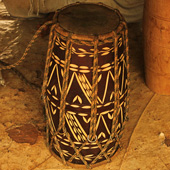Design Resource
Dholak Waale - Thanisandra
Folk Drum Player
by
Prof. Bibhudutta Baral, Divyadarshan C. S., Lija M. G. and Shruti K.
Dholaks are made of cardboard rolls and wood, cardboard rolls purchased through middlemen which are the leftover from textile industries. As cardboard rolls vary as per size and thickness it is evened with by removing the extra thickness from the rolls for the cardboard to get the good sound. Generally two cardboard rolls are fixed to get a size close to (one) feet, which is suitable for kids. First step is to fix the two cardboard rolls and dried under direct sunlight.
A mixture of Kataha (paan ka maale or color kataha) is mixed with water and chunna (lime stone), brushed to the surface of the cardboard and dried completely. Patterns are made on the outer surface is cut as per the requirement into the required shapes that adds value. The goat leather is soaked in the water for about 10-15 minutes and squeezed. Soap is applied on the leather sheets to which the bamboo sticks made to the ring form are placed on the leather sheets and locked. The mixture of sahi-kare (mixture of lambi (scorpion shells of tropical waters), grease, used engine oil and chalk ka mutti (lime stone powder)) is applied at the center and dried for some time for the sound production of the taal. Sahi-kare must be applied with only the required thickness.
The body of the cardboard roll is coated with a layer of wax for better finish after which it is scrap with the rapi tool to smoothen the surface. It is then applied with a coat of wood polish for the final finish. As the leather with the bamboo rings are made it is joined to the two ends of the cardboard rolls with the rope moving in a zigzag manner along with iron rings at one end for the production of the taal (rhythm).
Membrane and body (roll) are fasten using twine, stitched at seven places in a zigzag manner by adding metal rings along with the for producing the taal. Usually the number stitching may increase from 7 to 9, 11 or 13 as the size of dholak increases with minimum of 7 knots for the production of the sound (rhythm).
























